For a parasitologist, parasites in the human body are a standard work front. For an ordinary patient, helminthic invasion is a terrible pathology. The situation is exacerbated by the fact that a person is prone to increase the scale of the problem without recognizing the enemy by eye. Basic knowledge of the types of parasites that can live in the human body will help overcome fear. And knowing the problem, you can already competently build methods of treating it or principles of protection against it. In the material below, we will analyze which worms parasitize the human body.
Types of worms in the human body
It is worth noting that not all real life worms in the human body can live. For many people, the natural habitat is animal organisms, water or just soil. Below is a list of the most common parasites in the human body with accompanying clinical manifestations.
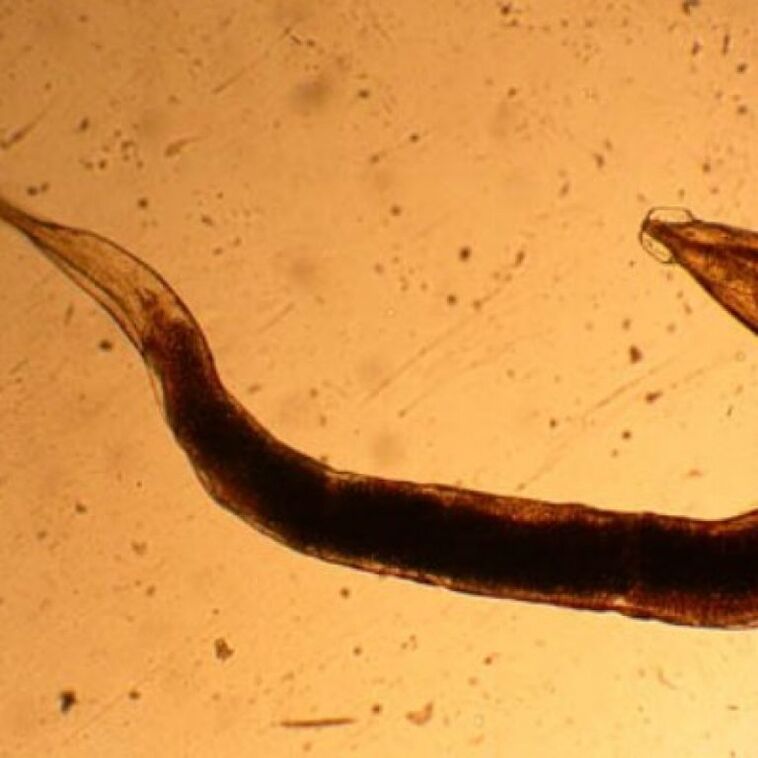
Stake worm
This is the most common parasite that enters the human body. Furthermore, humanoid primates can also suffer from enterobiasis. Most often, pinworm is localized in the body of preschool children. Children from 1 to 10 years old are sick.
Worm infection occurs when a healthy person comes in contact with an infected person (shaking hands, touching dirty underwear, towels, etc. ) in the condition of unwashed hands. Further, with food, worm eggs enter the human body.
Important: insects (flies, cockroaches) can also lay poisonous eggs.
An adult female crawls out of the anus at night and lays her eggs in the skin folds of the anus, causing severe itching. Also, the patient may experience periodic pain in the lower abdomen if the intensity of the helminthic invasion is already high. It is these symptoms of parasitic infection that indicate worms in the body. They can be confused with general fatigue and allergic skin reactions.
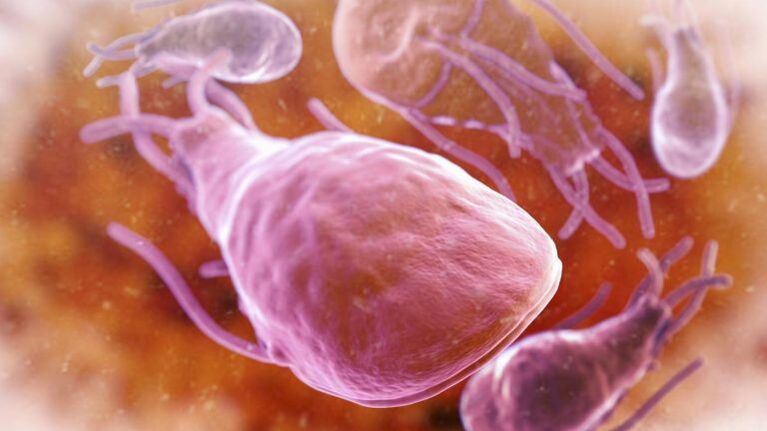
Giardia
Protozoa of the flagella genus. Localization of such parasites in the human body occurs most often in the small intestine. However, with blood flow, the protozoan can reach the liver and gallbladder. Parasites enter a person through dirty hands, unwashed vegetables / fruits, or by drinking contaminated water.
Symptoms of lamblia parasites are:
- Pain in the right hypochondrium;
- Stool disorders;
- Excessive gas;
- Mixed;
- Neurosis;
- Allergic manifestations on the skin.
Ascaris
Roundworms in people who live most often in the small intestine. But at the same time, with the flow of blood, they can easily migrate to any organ. Often localized in the heart, lungs, liver and even brain.
Infection with helminthic infection occurs through dirty hands, in which the parasite eggs from vegetables, fruits, soil, etc. can stay. In this case, the symptoms of the parasite vary depending on the stage of the disease course. So, during larval migration, the following symptoms of parasites are observed in the body:
- Increased body temperature (38 degrees);
- Dry cough at night with shortness of breath;
- Swollen lymph nodes.
With the further location of worms in the human body, the following symptoms are formed:
- Stool disorders (constipation and diarrhea);
- Nervous disorders;
- Pneumonia;
- Heart failure;
- Mixed;
- Vomiting;
- Frequent headaches;
- Stomach pain.
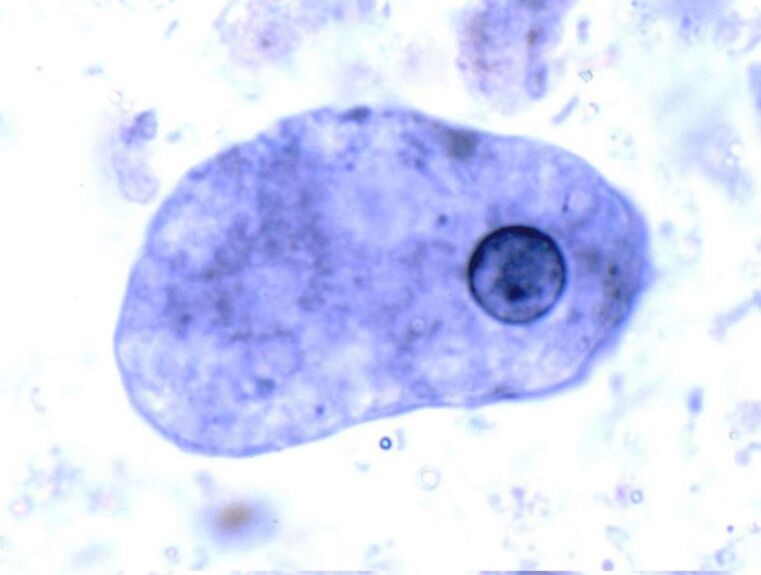
Histological amoeba
Amoeba is a protozoan parasite. It affects the human body through dirty hands, through the use of contaminated food (vegetables, fruits, herbs) and even through anal intercourse. Flies can also carry amoebae. Amoeba provokes the formation of ulcers in the walls of the large intestine and further damage to other organs and systems. In this case, the signs of parasites on the body will be as follows:
- Stools with blood and mucus;
- Abdominal pain;
- Anemia;
- General weakness and fatigue;
- The formation of abscesses in those organs in which the parasite can be located.
Toksokara
Round helminth that provokes a helminthic invasion called toxocariasis. In this case, the parasite can be localized in the intestine, in the eyes, in the brain. Carriers of toxocar are dogs (dogs, wolves, foxes, etc. ). Infection occurs either through contact with a sick animal, or through indirect contact with its feces. Infection with parasites of this type involves a variety of symptoms, depending on the organ in which the worm larva is located. So with intestinal toxocariasis, the symptoms will be as follows:
- Nausea and vomiting;
- Diarrhea and constipation;
- Abdominal pain.
With ocular toxocariasis, the patient has the following signs of parasitic infection:
- Decreased vision;
- Purulent discharge from the affected eye;
- Boils on the eyelids;
- Redness of the eye sclera;
- Retinal detachment.
If the toxocara is placed in the brain, then the patient has the following signs of the presence of a parasite in the body:
- Headache;
- Dizziness and fainting;
- Increased intracranial pressure;
- Nervousness and hallucinations;
- Decreased vision and concentration.
In this case, the clinical picture is often confused with brain oncology.
- With cardiac toxocariasis, the patient will experience heart failure, such as tachycardia, arrhythmia, valve failure, and heart pain.
- If the respiratory system is affected by toxocariasis, there will be signs of pneumonia or bronchitis, as well as frequent shortness of breath.
- If the worm is placed under the skin, then the patient will feel itching, movement and redness will be noticed on the skin at the location of the helminth.
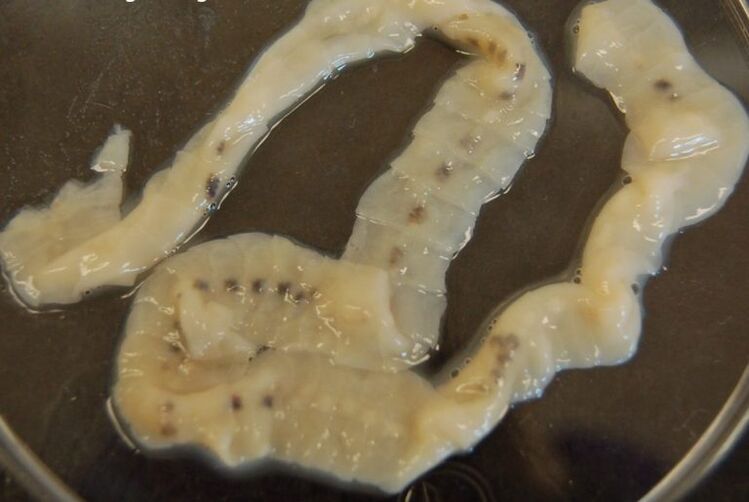
Wide bar
This helminth lives in the small intestine of its biological host. It gets there through the mouth along with contaminated food (fish, fish sticks) or water. Signs of worms on a body of this type are as follows:
- Abdominal pain;
- Mixed;
- Persistent anemia that cannot be corrected with iron supplementation;
- In an advanced stage of pathology, the patient develops an intestinal obstruction due to a large accumulation of parasites in it.
Pork ribbon
This helminth lives in the bodies of cattle (rabbits, pigs), as well as in the bodies of dogs and even camels. It enters the human body along with contaminated meat that has undergone insufficient heat treatment. If an adult worm is found in the patient's body, the diagnosis is "tenesmus". If helminth is detected in the larval stage, then the diagnosis is "cysticercosis".
Important: a patient with teniasis is dangerous both for himself (swallowing the parasite larvae in the brain, eyes, bone skeleton) and for others.
The list of parasite symptoms in the human body looks like this:
- A sharp decrease in appetite;
- Severe headaches;
- Abdominal pain;
- To faint;
- Decreased vision (with eye strain).
Important: treatment for swine fever is performed only in a hospital under the supervision of specialists.
.jpg)
Cattle ribbon (ribbon)
A parasite that lives in the human body in a single individual. Get there with infected beef. The list of signs of the parasite in the human body looks like this:
- Irresistible appetite and lack of weight gain;
- unstable chair;
- Abdominal pain;
- Severe allergic manifestations;
- Mixed.
Important: the parasite emerges on its own when using certain anthelmintic drugs. Moreover, its maximum length can be about 12 meters.
Nectar and claw worm
These round parasites enter the human body either routinely through contaminated hands and food, or through soil through contact with it. The symptoms of the presence of such parasites in the human body look like this:
- Redness of the body in the form of papules and blisters (acne with purulent contents);
- Severe dry cough with shortness of breath;
- Abdominal pain;
- Persistent anemia;
- Diarrhea;
- Mixed;
- Critical loss of appetite.

Alveokoku
This parasite belongs to the cestode group. At the same time, it is worth knowing that helminth is extremely dangerous to humans in that it first forms a major inflammatory focus in the liver, and then its metastases spread to other organs. Human infection occurs through ingestion of helminth oncospheres in the human mouth. Most often this occurs during the cutting of animal carcasses, during hunting, when you use plants and berries collected in the forest and insufficiently processed for food, as well as through direct contact with pets infected with the invasion. In this case, only a specialist should evaluate the symptoms and treatment tactics. The clinical picture of helminthic invasion looks like this:
- Nausea and specific numbness;
- Pain in right hypochondrium;
- Allergies;
- Severe itching of the skin;
- Supuration of the site where the parasite is located and the abscess erupts.
Important: The localization of such an invasion is often found in the lungs or brain. They just get rid of the parasite right away.
Ekinokoku
Canids and cats are carriers of echinococcus. In this case, a person for the parasite is only an intermediate host. The risk of echinococcosis to humans lies in the fact that the helminth seriously affects a person’s organs and systems, provoking the formation of cysts in them. Most often people who work with animals and butcher meat are infected with echinococcosis. That is, the parasite can enter the human body when it ingests the body of an animal, when it eats meat or contaminated water. It is worth noting here that the signs of the presence of parasites in an adult may not appear for a long time. When the asymptomatic phase is over, the following clinical picture appears:
- heavy hives;
- Itchy skin;
- Pain at the location of the parasite larva;
- Fever and fever (subject to cyst suppuration).
This type of helminth enters the human body through contaminated poultry, fish or frog meat. You can also become infected with contaminated water with worm larvae in it. The presence of such worms in the human body is manifested by the following symptoms:
- Severe dry cough;
- Pain in the area of the parasite larva location;
- severe swelling;
- Severe itching of the skin;
- Increase in body temperature.
Important: after a week, all symptoms disappear on their own, but reappear at regular frequency for many years. A major risk is eye and brain damage with worms. This can be fatal.
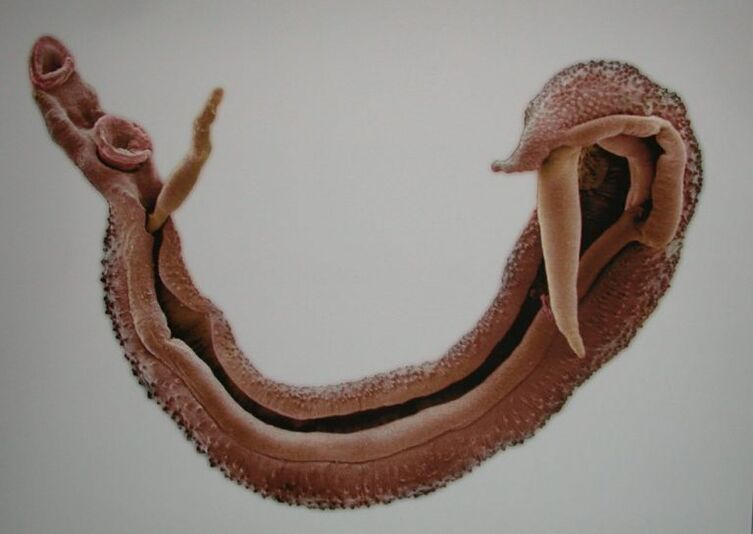
Schistosoma
Flux worm. It is dangerous because it can penetrate the human body even through intact skin. Infection occurs in dirty water (most often in Africa) when you wash clothes in polluted water or when you water the soil with it. In the acute phase of the invasion, the following first signs appear:
- Extremely high body temperature (up to 39 degrees and above);
- Papule formation in the body;
- Severe itching of the skin.
In the chronic phase, the disease appears in the form of symptoms of prostatitis, colitis, colpitis, ascites, renal hydronephrosis, etc. Schistosomiasis can be detected by analyzing urine.
Trichinella
A round parasite that parasitizes the muscles of the human body in the larval stage and migrates to the small intestine when it reaches maturity. Trichinella is deadly to humans. You can become infected from such an invasion when you eat fried / poorly cooked meat of worms and pets infected with worms. If the reader does not know how to determine the presence of such a parasite in the body, then the clinical picture of the pathology looks like this:
- Severe vomiting and diarrhea;
- Abdominal pain;
- Loss of appetite;
- Muscle pain;
- Skin rashes;
- Erosion of the eyelids;
- The temperature rises to 40 degrees.
Important: Trichinosis is the only helminthic invasion in the human body that is also treated with corticosteroid drugs.
By learning what parasites can live in the human body and how infection occurs, as well as what are the symptoms of helminthic infection, you can insure yourself and your loved ones from infection. And if you suspect infection with one or another type of parasite, seek specialized help in a timely manner.
























